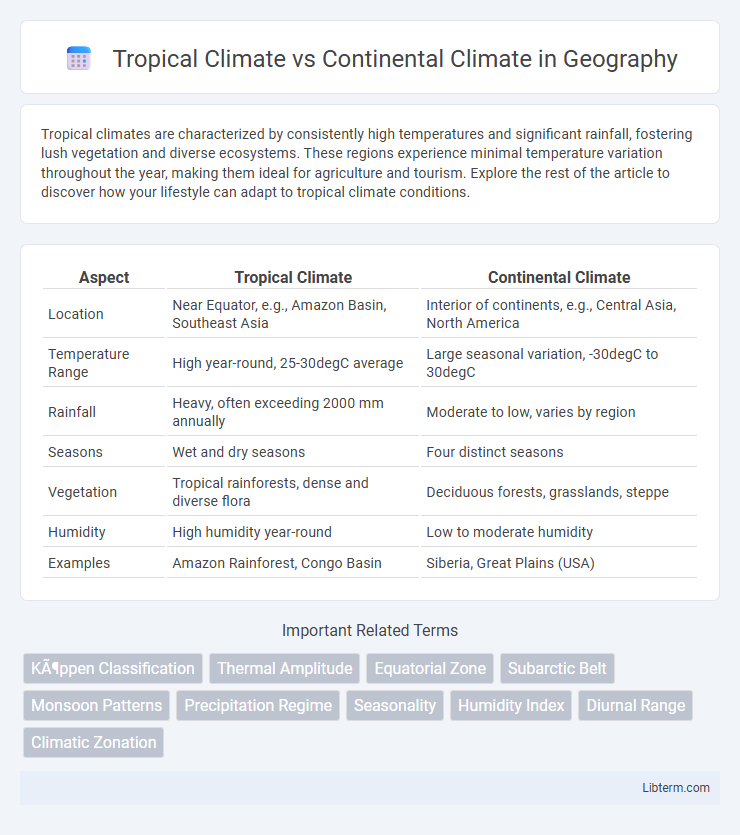Tropical climates are characterized by consistently high temperatures and significant rainfall, fostering lush vegetation and diverse ecosystems. These regions experience minimal temperature variation throughout the year, making them ideal for agriculture and tourism. Explore the rest of the article to discover how your lifestyle can adapt to tropical climate conditions.
Table of Comparison
| Aspect | Tropical Climate | Continental Climate |
|---|---|---|
| Location | Near Equator, e.g., Amazon Basin, Southeast Asia | Interior of continents, e.g., Central Asia, North America |
| Temperature Range | High year-round, 25-30degC average | Large seasonal variation, -30degC to 30degC |
| Rainfall | Heavy, often exceeding 2000 mm annually | Moderate to low, varies by region |
| Seasons | Wet and dry seasons | Four distinct seasons |
| Vegetation | Tropical rainforests, dense and diverse flora | Deciduous forests, grasslands, steppe |
| Humidity | High humidity year-round | Low to moderate humidity |
| Examples | Amazon Rainforest, Congo Basin | Siberia, Great Plains (USA) |
Introduction to Climate Zones
Tropical climates are characterized by consistently high temperatures and significant annual rainfall, supporting dense rainforests and diverse ecosystems near the equator. Continental climates exhibit greater temperature extremes, with hot summers and cold winters, typical of inland regions far from oceanic influence. These distinct climate zones influence vegetation patterns, agricultural practices, and human settlement distributions globally.
Defining Tropical and Continental Climates
Tropical climates are characterized by consistently high temperatures throughout the year, typically above 18degC (64degF), with abundant rainfall and minimal seasonal temperature variation, commonly found near the equator. Continental climates experience greater temperature extremes, featuring hot summers and cold winters, with significant seasonal temperature differences due to their location away from oceanic influence, typically in the interior regions of continents. These defining features influence vegetation patterns, human activities, and weather systems within each climate zone.
Geographic Distribution of Tropical and Continental Climates
Tropical climates are predominantly found near the equator between the Tropics of Cancer and Capricorn, covering regions in South America, Central Africa, Southeast Asia, and parts of the Pacific Islands, characterized by consistently high temperatures and significant annual rainfall. Continental climates occur primarily in the central and northeastern parts of North America, eastern Asia, and parts of Eastern Europe, marked by greater temperature extremes between summer and winter due to their inland location away from oceanic influence. The geographic distribution of these climates reflects the influence of latitude, altitude, proximity to oceans, and prevailing wind patterns on regional temperature and precipitation variations.
Temperature Patterns: Tropical vs Continental
Tropical climates exhibit consistently high temperatures year-round, typically ranging between 25degC to 30degC, with minimal seasonal variation due to their proximity to the equator. Continental climates experience significant temperature fluctuations, with hot summers often exceeding 30degC and cold winters dropping below -20degC, resulting from their inland locations far from moderating oceanic influences. These distinct temperature patterns reflect the fundamental difference in solar radiation exposure and geographic factors affecting each climate type.
Rainfall and Humidity Comparisons
Tropical climates experience high humidity levels often exceeding 70% year-round, accompanied by heavy and consistent rainfall, typically over 2000 mm annually, supporting dense rainforests. Continental climates have more variable humidity, usually lower than tropical regions, with annual precipitation generally ranging between 300-1000 mm, often concentrated in summer months. The marked difference in rainfall intensity and humidity levels defines distinct ecosystem types and weather patterns in tropical versus continental zones.
Seasonal Variations and Extremes
Tropical climates exhibit minimal seasonal variations with consistently high temperatures and distinct wet and dry seasons, characterized by frequent heavy rainfall during monsoons. Continental climates experience significant seasonal extremes, with hot summers often exceeding 30degC and cold winters dropping below -20degC, due to their inland locations and lack of moderating oceanic influence. These pronounced temperature fluctuations in continental climates lead to varied ecosystem adaptations, contrasting with the stable, year-round warmth of tropical regions.
Flora and Fauna Adaptations
Tropical climates support dense rainforests with diverse flora such as broadleaf evergreen trees, adapted to high rainfall and consistent temperatures, while fauna like toucans and jaguars exhibit traits suited to dense canopy living and steady food supplies. Continental climates, characterized by extreme temperature variations and seasonal changes, host flora including deciduous trees and grasses that endure cold winters and warmer summers; fauna such as bears and wolves demonstrate adaptations like hibernation and thick fur for survival. These distinct climate-driven adaptations in both flora and fauna highlight ecosystems optimized for the challenges of humidity and temperature stability in tropical zones versus temperature extremes in continental regions.
Human Lifestyle and Agricultural Practices
Tropical climates, characterized by high temperatures and abundant rainfall, promote year-round agricultural practices such as rice, sugarcane, and cocoa cultivation, supporting lifestyles reliant on farming and outdoor labor. In contrast, continental climates with distinct seasonal variations influence crop cycles, favoring grains like wheat and barley and necessitating storage and preservation techniques for harsh winters. Human lifestyles in continental regions often adapt to seasonal extremes with varied housing insulation and clothing, while tropical communities emphasize strategies for heat management and water resource utilization.
Challenges and Benefits of Each Climate
Tropical climates present challenges such as high humidity, intense rainfall, and heat, which can lead to health issues like heat exhaustion and increased prevalence of tropical diseases. However, these climates support rich biodiversity and enable year-round agriculture, benefiting crop diversity and productivity. Continental climates face extreme temperature variations and harsh winters that impact infrastructure and agriculture, but they offer distinct seasonal changes and fertile land conducive to diverse crop cycles.
Conclusion: Key Differences Between Tropical and Continental Climates
Tropical climates are characterized by consistently high temperatures and significant year-round precipitation, supporting lush vegetation and diverse ecosystems. Continental climates exhibit greater temperature variations between seasons, with hot summers and cold winters, often causing distinct seasonal changes in flora and fauna. These climatic contrasts profoundly influence regional agriculture, lifestyle, and biodiversity patterns.
Tropical Climate Infographic

 libterm.com
libterm.com